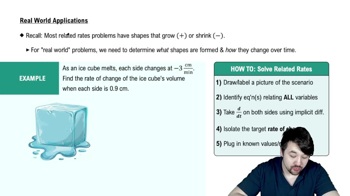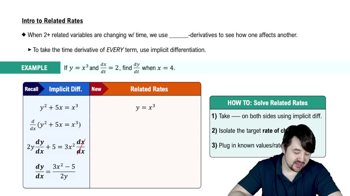Table of contents
- 0. Functions7h 52m
- Introduction to Functions16m
- Piecewise Functions10m
- Properties of Functions9m
- Common Functions1h 8m
- Transformations5m
- Combining Functions27m
- Exponent rules32m
- Exponential Functions28m
- Logarithmic Functions24m
- Properties of Logarithms34m
- Exponential & Logarithmic Equations35m
- Introduction to Trigonometric Functions38m
- Graphs of Trigonometric Functions44m
- Trigonometric Identities47m
- Inverse Trigonometric Functions48m
- 1. Limits and Continuity2h 2m
- 2. Intro to Derivatives1h 33m
- 3. Techniques of Differentiation3h 18m
- 4. Applications of Derivatives2h 38m
- 5. Graphical Applications of Derivatives6h 2m
- 6. Derivatives of Inverse, Exponential, & Logarithmic Functions2h 37m
- 7. Antiderivatives & Indefinite Integrals1h 26m
- 8. Definite Integrals3h 25m
4. Applications of Derivatives
Related Rates
Problem 7c
Textbook Question
The volume V of a sphere of radius r changes over time t.
c. At what rate is the radius changing if the volume increases at 10 in³ when the radius is 5 inches?
 Verified step by step guidance
Verified step by step guidance1
Start with the formula for the volume of a sphere, which is given by V = (4/3)πr³.
Differentiate both sides of the volume formula with respect to time t to find the relationship between the rate of change of volume (dV/dt) and the rate of change of radius (dr/dt). This gives you dV/dt = 4πr²(dr/dt).
Substitute the known values into the differentiated equation: set dV/dt = 10 in³ and r = 5 inches.
Solve the equation for dr/dt, which represents the rate at which the radius is changing.
Interpret the result in the context of the problem to understand how the radius is changing as the volume increases.
Recommended similar problem, with video answer:
 Verified Solution
Verified SolutionThis video solution was recommended by our tutors as helpful for the problem above
Video duration:
4mPlay a video:
Was this helpful?
Related Videos
Related Practice






